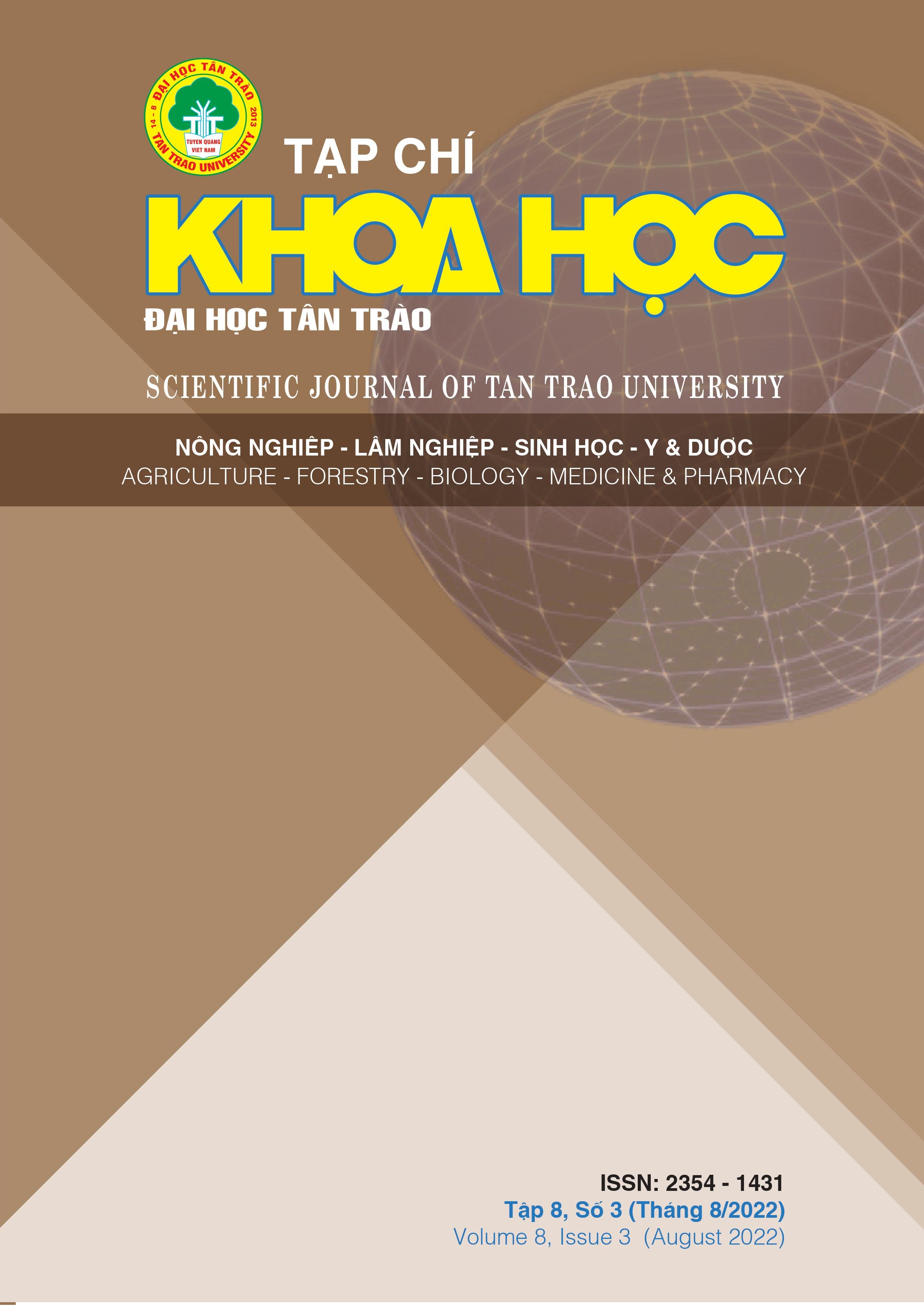CHEMICAL COMPOSITION AND ANTIOXIDANT ACTIVITITES FROM ETHYL ACETATE EXTRACT OF MORINDA OFFICINALIS COLLECTED IN DAK LAK
Keywords:
Morinda officinalis, GS-MS, ethyl acetate, antioxidant activity, Dak LakAbstract
Morinda officinalis is a species of herbal plant belonging to the genus Morinda L., the coffee family (Rubiaceae), this species is widely distributed in the northern mountainous provinces, the Central Highlands and the province China's Guangxi. Currently, Morinda officinalis is propagated and grown in Dak Lak province and is used as a medicine. In this study, we determined the chemical composition of ethyl acetate root extract and evaluated the antioxidant activity of the extract obtained by DPPH method.
The results of determining the chemical composition of the ethyl acetate extract have 15 compounds, the main classes of which are: anthraquinones, triterpenes, organic acids. Evaluation of high oxidizing mineral activity of ethyl acetate extract by DPPH method showed very strong antioxidant capacity with IC50 = 3.33 mg/ml, 10.5 times stronger than ascorbic acid positive control (IC50 = 34.99 mg/ml).
Downloads
References
[1]. Ministry of Health. (2009). Vietnamese Pharmacopoeia IV. Medical Publishing House, Vietnam.
[2]. Zhenhua Luo, Zien Chen, Mengyun Liu, Li Yang, Zhimin Zhao, Depo Yang and Ping Ding. (2022). Phenotypic, chemical component and molecular assessment of genetic diversity and population structure of Morinda ofcinalis germplasm. Luo et al. BMC Genomics 23:605, P.1-17.
[3]. Chieu, N. (2001). Primary results of the investigation of planting Ba kich in Phu Tho, Journal of Pharmacology, 297(1):6-9.
[4]. Loi, V. D., Vung, N. T., An, N. T. T. (2016). Some compounds isolated from the roots of Morinda officinalis How grown in Quang Ninh province. Journal of Pharmacology, 485(9):36-41.
[5]. Quan, N. M., Huong, N. T. G. (2008). Study on the effect of Morinda officinalis How on the development of male rat genitals, Medical Research Journal, 53(1):77-84.
[6]. Tien, T. M., Tam, N. M. T., Luan, T. C., Huong, N. Thi. T. (2012). Study on the androgenic effect of Morinda officinalis How. Medical Journal of Ho Chi Minh City, 16 (1):192-198.
[7]. Wu,Y. B., Wu, J. G., Zheng, C. J., Han, T., Qin, L. P., Wu, J. Z., Zhang, Q. Y. (2013). Quantitative and chemical profiles analysis of the root of Morinda officinalis based on reversed-phase high performance liquid chromatography combined with chemometrics methods. Journal of Medicinal Plants Research, 7(30):2249 - 2258.
[8]. Yoon, K. L., Hyo, J. B., Jeong, B. O., Wan, K. W. (2017). Bioassay-Guided Isolated Compounds from Morinda offificinalis Inhibit Alzheimer’s Disease Pathologies. Molecule, 22:1638.
[9]. Hung, T. V., Kien, P. V., Thai, B. Q., Son, D. C., Dat, N. T., Cuong, B. H. (2017). Study on extracting, isolating and purifying monotropein from the root of Morinda offificinalis to establish standard substances. Journal of Pharmacology, 57 (5):40 – 42.
[10]. Zang, J. H., Xin, H. L., Xu, Y. M., Shen, Y., He, . Y. Q., Hsien-Yeh, Lin, B., Song, H. T., Juan-Liu, Yang, H. Y., Qin, L. P., Zhang, Q. Y., Du, J. (2018). Morinda officinalis How. - A comprehensive review of traditional uses, phytochemistry and pharmacology. Journal of Ethnopharmacology, 213:230-255.
[11]. Yoshikawa, M., Yamaguchi, S., Nishisaka, H., Yamahara, J., Murakami, N. (1995). Chemical constituents of Chinese nature medicine, morindae radix, the dried roots of Morinda officinalis How: Structures of morindolide and morofficinaloside. Chemical and Pharmaceutical Bulletin, 43(9):1462-1465.
Downloads
Published
How to Cite
Issue
Section
License

This work is licensed under a Creative Commons Attribution-ShareAlike 4.0 International License.
All articles published in SJTTU are licensed under a Creative Commons Attribution-ShareAlike 4.0 International (CC BY-SA) license. This means anyone is free to copy, transform, or redistribute articles for any lawful purpose in any medium, provided they give appropriate attribution to the original author(s) and SJTTU, link to the license, indicate if changes were made, and redistribute any derivative work under the same license.
Copyright on articles is retained by the respective author(s), without restrictions. A non-exclusive license is granted to SJTTU to publish the article and identify itself as its original publisher, along with the commercial right to include the article in a hardcopy issue for sale to libraries and individuals.
Although the conditions of the CC BY-SA license don't apply to authors (as the copyright holder of your article, you have no restrictions on your rights), by submitting to SJTTU, authors recognize the rights of readers, and must grant any third party the right to use their article to the extent provided by the license.





